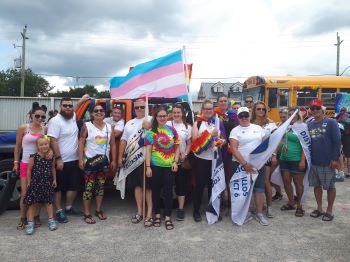 ALLY: An individual (usually heterosexual and cisgender) who is supportive of the LGBTQ2SIA+ community. They believe in the dignity of and respect for all people, and are willing to stand up in that role. Allies do not identify as members of the group they are fighting for; in this case someone heterosexual would be an ally for the LGBTQ2SIA+ community, but a lesbian (for example) could be an ally for the trans community.
ALLY: An individual (usually heterosexual and cisgender) who is supportive of the LGBTQ2SIA+ community. They believe in the dignity of and respect for all people, and are willing to stand up in that role. Allies do not identify as members of the group they are fighting for; in this case someone heterosexual would be an ally for the LGBTQ2SIA+ community, but a lesbian (for example) could be an ally for the trans community.
ANDROGYNOUS: Identifying and/or presenting as neither distinguishably masculine nor feminine.
ASEXUAL: The lack of a sexual attraction or desire for other people.
BIPHOBIA: Prejudice, fear or hatred directed toward bisexual people.
BISEXUAL: A person emotionally, romantically or sexually attracted to more than one sex, gender or gender identity though not necessarily simultaneously, in the same way or to the same degree.
CISGENDER: A term used to describe a person whose gender identity aligns with those typically associated with the sex assigned to them at birth.
CLOSETED: Describes an LGBTQ2SIA+ person who has not disclosed their sexual orientation or gender identity.
COMING OUT: The process in which a person first acknowledges, accepts and appreciates their sexual orientation or gender identity and begins to share that with others.
GAY: A person who is emotionally, romantically or sexually attracted to members of the same gender.
GENDER DYSPHORIA: Clinically significant distress caused when a person’s assigned birth gender is not the same as the one with which they identify. According to the American Psychiatric Association’s Diagnostic and Statistical Manual of Mental Disorders (DSM), the term
– which replaces Gender Identity Disorder – “is intended to better characterize the experiences of affected children, adolescents, and adults.”
GENDER-EXPANSIVE: Conveys a wider, more flexible range of gender identity and/or expression than typically associated with the binary gender system.
GENDER EXPRESSION: External appearance of one’s gender identity, usually expressed through behaviour, clothing, haircut or voice, and which may or may not conform to socially defined behaviors and characteristics typically associated with being either masculine or feminine.
GENDER FLUID: The belief that social constructions of gender identity and gender roles lie along a spectrum and cannot be limited to two genders; a feeling that one’s gender varies from societal notions of two genders.
GENDER IDENTITY: One’s innermost concept of self as male, female, a blend of both or neither – how individuals perceive themselves and what they call themselves. One’s gender identity can be the same or different from their sex assigned at birth.
GENDER NON-CONFORMING: A broad term referring to people who do not behave in a way that conforms to the traditional expectations of their gender, or whose gender expression does not fit neatly into a category.
GENDERQUEER: Genderqueer people typically reject notions of static categories of gender and embrace a fluidity of gender identity and often, though not always, sexual orientation. People who identify as genderqueer may see themselves as being both a man and a woman, neither a man nor a woman or as falling completely outside these categories.
HOMOPHOBIA: The fear and hatred of or discomfort with people who are attracted to members of the same sex.
INTERSEX: An umbrella term used to describe a wide range of natural bodily variations. In some cases, these traits are visible at birth, and in others, they are not apparent until puberty. Some chromosomal variations of this type may not be physically apparent at all.
LESBIAN: A woman who is attracted physically and emotionally to other woman.
LGBTQ2SIA+: An acronym for Lesbian, Gay, Bisexual, Transgender, Transsexual, Queer and Questioning Two-Spirit, Intersex, Asexual, Plus people.
NON-BINARY: An adjective describing a person who does not identify exclusively as a man or a woman. Non-binary people may identify as being both a man and a woman, somewhere in between, or as falling completely outside these categories. While many also identify as transgender, not all non-binary people do.
PANSEXUAL: Describes someone who has the potential for emotional, romantic or sexual attraction to people of any gender though not necessarily simultaneously, in the same way or to the same degree.
QUEER: Sometimes used as an umbrella term for the LGBTQ2SIA+ community. Some people may also identify as queer instead of or in addition to more rigid identity categories. Historically a negative term, it has been reclaimed by many in the LGBTQ2SIA+ movement in the last few decades.
QUESTIONING: A person who is unsure of their sexual orientation or gender identity.
SEXUAL IDENTITY/ORIENTATION: An inherent or immutable enduring emotional, romantic or sexual attraction to other people.
SEX ASSIGNED AT BIRTH: The sex (male or female) given to a child at birth, most often based on the child’s external anatomy. This is also referred to as “assigned sex at birth.”
TRANSGENDER: An umbrella term for people whose gender identity and/or expression is different from cultural expectations based on the sex they were assigned at birth. Being transgender does not imply any specific sexual orientation. Therefore, transgender people may identify as straight, gay, lesbian, bisexual, etc.
TWO-SPIRIT (OR 2-SPIRIT): Some Indigenous people identify themselves as Two Spirit rather than as lesbian, gay, bisexual or transgender. Historically, in many Indigenous cultures, Two-Spirit persons were respected leaders and medicine people. Two-Spirit persons were often accorded special status based upon their unique abilities to understand both male and female perspectives.
